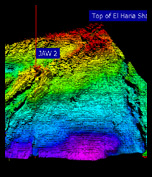PROJECTS |
JAWHARA DISCOVERYIn 1976 Total discovered oil when it drilled the Jawhara #1 (JAW1) to a depth of 3,245m. The Douleb was tested in the interval 2,420-30m and flowed at a rate of 1,267 BFPD, with water cuts varying between 10% and 25% during two test periods of up to 8 hours and thirty minutes. The oil gravity was measured from 24º to 31º API and water salinity was measured around 34,000 ppm NaCl. The majority of the water produced from this interval is believed to be filtrate (27,500 ppm NaCl) due to variance of salinity from tests in zones above and below the test interval within the same wellbore. A zone deeper in the Bireno (2,464-65.7m) tested 33 percent oil and 67 percent water (85,000 ppm NaCl) upon DST, but did not flow. This test defined the lowest known oil at -2,440 meters subsea which was utilized to define the oil/water contact for purposes of determining recoverable hydrocarbon volumes. The Jawhara #2 (JAW2) was drilled in 1980 to a depth of 3,554m to test an apparent crestal position of the Jawhara feature based on sparse 2D seismic coverage. Unfortunately, the prospective Douleb/Bireno reservoir was faulted out of this well. In general, the reservoir characteristics of the Douleb/Bireno include porosities that range from 12% to 25% with corresponding permeabilities that range from < 1 mD to over 500 mD.
The Jawhara #2 (JAW2) was drilled in 1980 to a depth of 3,554m to test an apparent crestal position of the Jawhara feature based on sparse 2D seismic coverage. Unfortunately, the prospective Douleb/Bireno reservoir was faulted out of this well. In general, the reservoir characteristics of the Douleb/Bireno include porosities that range from 12% to 25% with corresponding permeabilities that range from < 1 mD to over 500 mD.
In 2004 APEX acquired a high resolution 3D survey over the Jawhara structure to confirm the presence of a commercial volume of hydrocarbons. APEX’s interpretation of the 3D on the top of the Douleb/Bireno interval indicates a faulted structure aligned north-northeast with faults generally aligned north-northwest. There are six fault segments that are prospective above the oil/water contact. Gaffney Cline and Associates, at the request of APEX and its partner, conducted an independent review of the exploration potential of the Sfax Offshore Permit. On October 5, 2007 GCA rendered an opinion that stated succinctly that two of the six fault segments mapped by APEX were believed commercially productive, containing Contingent Resources of nearly 34 million barrels of oil having a Net Present Value (PV10) of $200 million USD. APEX is currently evaluating options for the development of the Jawhara Discovery once development of the Ras El Besh Field is underway. APEX anticipates that it will submit a Plan of Development for the Jawhara area and request a Concession be granted by Tunisian authorities prior to year end 2008. |

